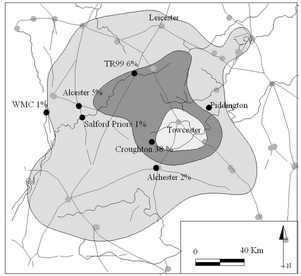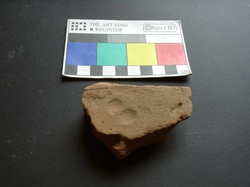
Anyhow the opening of the paper is a very quick summary of the potential of CBM - because we need to have a clear idea about what we are asking before we ask the question. ('How can we find anything if we don't know what we are looking for?' to paraphase Kant)
and one of the examples I'm interested in is supply - in the later Roman Period in Britain we see the rise of a few regionally dominant industries (after a much more locally based industry with itinerant tile makers up to the early 2nd)
I have now identified Crambeck, Horningsea, Harrold, Holme-on-Spalding Moor and Towcester pink grog tempered manufacturies. For the latter Jeremy Taylor has produced a distribution for the pottery in this fabric (JRPS4) over which I have overlaid the fabric proportions from sites in which I have identified the same fabric in CBM - both roof tile and flue tile - shown above.
The distribution match quite nicely , although I would like to have a few more points in the distribution map. I will also need to do further work on what specific CBM forms are being distributed, and with what pottery forms. Given that the unit of distribution is the roof load, or the hypocaust load, I wouldn't expect distribution pattens to be the same as for pottery - perhaps much more stepped - and there is the intriguing question of which product is being shipped with what - or is it more complicated than that?
Anyway the main point is that these late Roman tiles are the last roofing in the Roman period - the buildings are deserted and collapse or are demolished, so the majority of the tile is in the tip soil - two of the projects above are field walking surveys, which suggests that excavating topsoil and keeping the roof tiles is actually a useful thing to do. Not too sure how persuadable field specialists would be on this topic.


 RSS Feed
RSS Feed
